Reports on Plant Diseases | RPD No. 203 - Corn Smuts |
February 1990 |
[ Common Smut ] [ Symptoms
] [ Disease Cycle ] [ Control
]
[ Head Smut ] [ Symptoms
] [ Disease Cycle ] [ Control
]
Corn smuts occur throughout the world. Common corn smut, caused by the fungus
Ustilago zeae (synonym U. maydis), and head smut, caused by the
fungus Sporisorium holci-sorghi (synonyms Sphacelotheca reiliana,
Sorosporium reilianum and Sporisorium reilianum), are spectacular
in appearance and easily distinguished. Common smut occurs worldwide wherever
corn (maize) is grown, by presence of large conspicuous galls or replacement
of grain kernels with smut sori. The quality of the remaining yield is often
reduced by the presence of black smut spores on the surface of healthy kernels.
|
Common Smut
Common smut is well known to all Illinois growers. The fungus attacks
only corn–field corn (dent and flint), Indian or ornamental corn,
popcorn, and sweet corn–and the closely related teosinte (Zea
mays subsp. mexicana) but is most destructive to sweet corn.
The smut is most prevalent on young, actively growing plants that have
been injured by detasseling in seed fields, hail, blowing soil or and
particles, insects, "buggy-whipping", and by cultivation or
spraying equipment. Corn smut differs from other cereal smuts in that
any part of the plant above ground may be attacked, from the seedling
stage to maturity.
Losses from common smut are highly variable and rather difficult to measure,
ranging from a trace up to 10 percent or more in localized areas. In rare
cases, the loss in a particular field of sweet corn may approach 100 percent.
With resistant varieties and hybrids, annual losses seldom exceed 1 percent
in large areas. The number, size, and location of the smut galls or "boils"
on a plant affect the yield loss. The reduction in yield is greatest when
large galls are located on or above the ear. Plants with galls on the
lower stalks may be barren or may produce several small ears. Such plants
often appear reddish in the fall, resembling those heavily infested with
aphids earlier in the season. Leaf galls and galls resulting from detasseling
are usually small and generally cause little damage. The heaviest smut
infection generally occurs when rainfall is light during the early stages
of growth and temperatures are between 79 and 93 F (26 and 34 C).
|

Figure 1. Infection
of common corn smut on the ear. Smut galls are covered by the silvery
white membrane.
|
Vigorous plants are most susceptible, but may escape the more serious effects
of smut because of their rapid growth. Corn growing in soil particularly high
in nitrogen and organic matter (for example, barnyard manure) frequently shows
more smut than corn growing in soil with well-balanced fertility. Dry weather,
during which corn growth is slowed, and, abnormally cool, wet weather that retards
growth of young corn plants are both conducive to infection. Early infection
may stunt or kill young seedlings, although such an occurrence is rare.
Smut galls are not poisonous to animals except as they increase the
dust content of dry fodder. In fact, immature smut galls are considered a delicacy
in some South American countries.
Back to Top
|
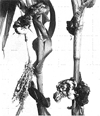
Figure 2.
Common smut on a corn tassel and stalk. The galls are rupturing, exposing
millions of black, powdery smut spores.
|
Symptoms
Common corn smut is easily recognized and is probably the best known
disease on corn. All actively growing or embryonic corn tissue is susceptible.
Galls are commonly found on the tassels, husks, ears and kernels, stalks,
leaves, axillary buds and, rarely, on the aerial roots. As the smut galls
enlarge, they are covered by a glistening, greenish to silvery-white membrane.
Later, the inner tissue darkens as a result of spore formation (Figure
1). Mature galls may reach 6 inches (15 centimeters) in diameter and are
filled with millions of microscopic, dark, olive brown to black, greasy
to powdery spores–except for the small, hard, pea-sized galls that
form on the leaves. The spores (teliospores, sometimes called chlamydospores)
are released when the whitish outer membrane of the gall ruptures at maturity
(Figure 2).
|
Back to Top
|
The diploid (2N) teliospores,
which are very resistant to freezing and drying, may survive in the soil or corp
debris for several years. During spring and summer, when the temperature is between
50 and 95 F (10 to 35 C) and moisture is present, the black, globose or subglobose,
spiny teliospores which are 8 to 12 m in diameter, germinate to form a 4-celled
basidium (promycelium) that produces from 4 to a large number of oval, haploid
(N) sporidia or basidiospores, which are of two sexes, (+) and (-) (Figure 3).
The sporidia are blown about by air currents or are splashed by water to young,
developing tissues of corn plants. Infection occurs when the + and - sporidia
germinate to form fine hyphae that penetrate into corn tissue through stomata,
wounds, or directly through cell walls. The hyphae of two compatible sporidia
fuse. The resulting hypha enlarges in diameter, becomes binucleate and dikaryotic
(N+B), and stimulates an increase in size and number of cells in the corn plant
forming a gall. Infection may also occur from hyphae arising directly from germinating
teliospores. Ears of corn are infected by hyphae growing through the silks much
like pollen grains.
The smut mycelium in a gall grows between the corn cells until just before
the teliospores are formed. The enlarged corn cells are then invaded,
collapse and die. The smut fungus feeds on the cell contents for its further
growth and the gall then consists primarily of dikaryotic mycelium and
the remains of corn cells. Most of the smut cells develop into teliospores
which absorb and utilize the contents of other mycelial cells. Only the
membrane covering the smut gall is unaffected by the fungus.
|
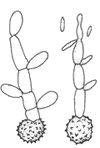
Figure 3. Germinated
teliospores of the common smut fungus (Ustilago zeae) with a 4-celled
basidium bearing 4 sporidia (drawing by L. Gray). |
The interval between infection and the formation of mature galls varies from
one to several weeks under favorable conditions. Spores formed in the first
smut galls may germinate and infect the same or other corn plants, although
most spores fall to the ground or remain in corn debris. Galls form and spores
are disseminated more or less continuously through the summer growing period.
When animals eat "smutty" stalks, leaves, and ears, the spores may
remain alive when passing through the alimentary canal and can be carried in
the manure. When infested manure is spread on crop land, sporidia produced by
the germinating teliospores may be blown or washed to the surface of a corn
plant, germinate, and cause infection. Smut spores are killed by the acids in
silage.
Back to Top
|
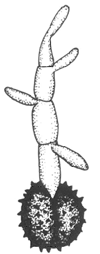
Figure
4. Germinated
teliospore of the head smut fungus (Sporisorium holcisorghi) with
a 4-celled basisium bearing 4 sporidia (drawing by L. Gray).
|
- Corn hybrids differ in apparent resistance. Choosing the best
adapted, resistant hybrids and varieties available is the best means
of controlling common smut. Such hybrids possess generalized or field
resistance to the corn-smut fungus. The difference in apparent resistance
between corn lines is often based on the protection given by the sheath
and husks. Corn breeders generally avoid using very smut-susceptible
inbreds and their hybrids or varieties.
- Maintain well-balanced soil fertility based on a soil
test.
- Avoid mechanical injuries to plants during cultivation
and spraying.
- Protect corn against insects (such as corn earworms
and European corn borers) by timely applications of insecticides recommended
by University of Illinois Extension Entomologists. This often decreases
the incidence of common smut in sweet corn.
- In home gardens, cut out and destroy the galls before
the smut "boils" rupture and the teliosporses are released.
The following practices are both effective in Illinois for controlling
common smut: fungicide seed treatment, crop rotation, and plowing down
smut-infested debris.
|
Back to Top
Head Smut
Head smut occurs sporadically in the United States and in drier soils
in many countries where corn is grown. The disease has not yet been reported
in Illinois. However, Illinois growers should be familiar with this disease
and its symptoms because it is present in other corn-growing states in
the Midwest. It is more common in drier soils of California, Idaho, New
Mexico, Oklahoma, Oregon, Texas, Utah, and Washington. However, it also
has been reported in Minnesota, Nebraska, Indiana, Iowa, Kansas, Ohio,
and New York. Yield losses result from the replacement of the ear with
large smut sori. Replacement of the tassel with sori can seriously affect
the efficiency of pollination. Resistant hybrids are known and most field
corn is highly tolerant. Sporisorium holci-sorghi does not exclusively
infect corn. Sorghums, teosinte, pitscalegrass, and Sudangrass also are
hosts of the fungus. Pathogenic specialization occurs in the head smut
fungus with one group limited to corn and another to grain sorghums, sorgo,
forage-sorghum hybrids, and some Sudangrass varieties. A hybrid of S.
holci-sorghi has been identified that infects both corn and sorghums.
|
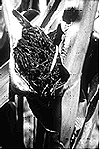
Figure
5. Corn
ear destroyed by head smut. Note the tangled mass of earlike strands (remnants
of the vascular system).
|
Back to Top
|
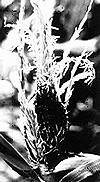
Figure
6. Corn tassel partially covered by a sorus of head smut.
|
Symptoms
Head smut is not evident until the tassels and ears appear. It is characterized
by the presence of sori on the the tassels, ears, or rarely, the leaves.
A sorus (plural sori) is a compact mass of dark brown to black spores
(teliospores) covered with a thin grayish white membrane which soon ruptures
to release a powdery mass of spores which are quickly scattered by air
currents and rain. A tangled mass of threadlike strands, vestiges of the
vascular system of the corn inflorescence, ramify through the sori and
are characteristic of infection by the fungus (Figure 4). The presence
of the vascular strands, surrounded by the mass of black-brown spores,
distinguishes head smut from common smut. Infected tassels are completely
or partially covered by a sorus (Figure 5) and normally do not produce
pollen. The individual florets are replaced entirely by teliospores without
the formation of a gall that is characteristic of common smut.
|
Back to Top
|
The head smut fungus overwinters as teliospores in the soil and occasionally
on the seed. Survival is better in dry than in moist soils. The microscopic
diploid (2N) teliospores are reddish brown to black, globose to subglobose,
abundantly and conspicuously spiny, and 9 to 14 m in diameter. Teliospores
may germinate in either one of two ways: directly in soil by producing
a long dikaryotic (N+N) infection hypha or indirectly by forming a basidium
on which lateral sporidia (basidiospores) are borne (Figure 8). The 1-celled
sporidia are haploid (N), hyaline, subglosose, and 7 to 15 m in diameter.
Sporidia of opposite mating types (+ and -) exist in approximately equal
numbers. Seedling infection occurs when sporidia of opposite mating types
fuse, forming a dikaryotic (N+N) germ tube or infection hypha. The parasitic
mycelium develops systemically, invading the meristematic tissue of seedlings
and later the undifferentiated ear and tassel tissues. Part or all of
these tissues develop into smut sori in which teliospores are produced.
Teliospores from smutted tassels and ears overwinter in soil and can survive
for 3 or more years.
|
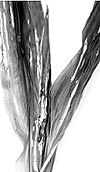
Figure
7. Proliferation
of leaf-like and husklike structures (phyllody) of a corn ear affected
by head smut.
|
|
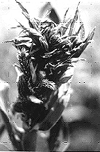
Figure
8. Stripes in corn leaves filled with teliospores of the head smut
fungus.
|
High soil moisture and winter soil temperatures above 32 F
(0 C) lead to decreased survival. Although the teliospores may be seedborne,
this is not an important source of inoculum. Teliospores also may be introduced
into a field by contaminated harvesting, planting, or cultivation equipment,
which transport spores from a diseased to a disease-free field. The infection
level is related to low soil moisture (15% to 25% W/w) are optimal for seedling
infection. Temperature is more important than soil moisture for infection.
Head smut is more prevalent in clay loam soils than in sandy loam or silt
loam soils and is accentuated by nitrogen deficiency. |
Back to Top
1. Plant
resistant varieties and hybrids; most commercial hybrids in the United States
are highly tolerant. 2. Rotate corn with other crops. Isolates of
the fungus that infect corn usually do not infect sorghums and vice versa. Other
crops, such as soybeans, small grains, and forage cropsa re not susceptible. 3.
Fungicides applied to soil at or before planting may be useful in reducing inoculum
in seed production fields. 4. Application of a protective fungicide seed
treatment (e.g., captan) is only partially effective while a systemic fungicide,
such as carboxin (Vitavax), is reported to give good protection. 5. Maintain
balanced fertility based on a soil test.
6. Where feasible, promptly remove and burn smutted tassels and ears
before the spores are scattered.
Back to Top
For further information concerning diseases of crucifers
and other vegetables, contact Mohammad Babadoost, Extension Specialist in Fruit
and Vegetable Diseases, Department of Crop Sciences, University of Illinois at
Urbana-Champaign. University of Illinois
Extension provides equal opportunities in programs and employment. |



